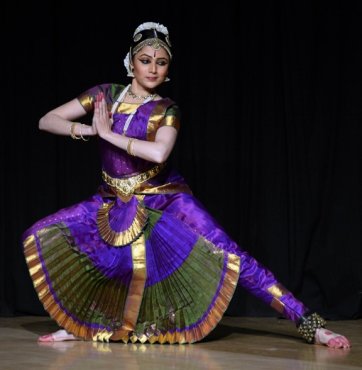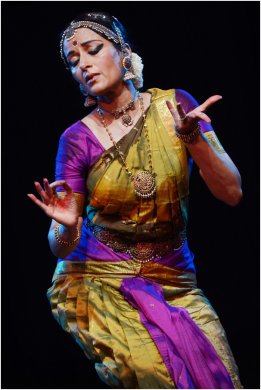
|   |

|   |
Margams by Indu Santhosh and Vidya Subramanian - Satish Suri e-mail: satishism@yahoo.co.in Photos: Shandilya Srivatsa February 17, 2015 Indu Santhosh, student of Shobhanaa Bhalchandra, a senior disciple of the Dhananjayans, presented a margam under the aegis of Indiranagar Sangeetha Sabha, Bangalore, on Jan 28, 2015.  Indu Santhosh
A trikalajati composed by Adyar Lakshman resounding with the word Nandi opened the invocatory piece “Nandi chollu” set in raga Vasantha and adi tala. Verses in praise of Lord Shiva embellished with brief nritta segments and sancharis of Nandi as the player of the drum and the vehicle of Siva were effectively portrayed by the artist to establish her competence. The devarnama “Jaganmohanane Krishna” was a compact delineation of the avatars of Vishnu and the pranks of little Krishna ending with a sanchari of little Krishna and Poothana who is finally liberated. The artist recalled each of the incarnations with a graphic representation of events and emotions. In the varnam “Nadhanai azhaithu va sakhiye” of Thiruveezhimalai Natarajasundaram Pillai in Khamboji and adi talam, the sthayi bhava showing the pining nayika cajoling, pleading, reprimanding and offering monetary compensation to the sakhi to be her messenger of love and bring Lord Muruga to her side was aesthetically presented. The sancharis depict the pangs of love, the feeling of separation (viraha) which is unbearable to the extent that she questions whether her lord is heartless or his heart is made of hard rock. The many moods of the nayika as she reminisces about her lord, her blushing countenance, the anguish as the arrows of Manmatha strike and the final joy of sambhogha was sensitively handled. The charanam “Nadopadesam arulvai sundaram” speaks of the greatness of Muruga. The nayika requests the sakhi to set forth and “bring that great lord to me, the one who gave the Pranava to his father, the mighty Shiva.” Muruga initiating Shiva in chanting the Pranava, and the sense of awe and pride in Shiva’s face were delightfully executed. Indu maintained a fine balance of nritta and abhinaya and the progress of the varnam was delightful in its lyrical and dance interpretation. The execution of the jathis was brisk and the adavus graceful, blending with the rhythm the dancer maintained with the nattuvangam of Prasanna and the percussion of V.R. Chandrasekhar. The Kshetrayya padam “Chudare” in ragam Sahana brought forth Indu’s flair for abhinaya. The petty gossip, tinged with jealousy and inquisitiveness about the abhisarika nayika’s liaison and complete disregard for social decorum and society’s derisions was rendered in a convincing manner. Indu then portrayed a popular light hearted Tamil folk song “Maadu meikkum Kanne” showing Yashoda cautioning Krishna not to run away and to be careful while Krishna ever eager to slip away, manages a variety of excuses. The thillanna in ragam Nalinakanti and adi talam, a composition of the violin maestro Lalgudi Jayaraman, provided a fitting finale to the performance. Orchestral support added to the overall impact of the performance - the bhava laden singing of Nandakumar Unnikrishnan supported by the mridangam expertise of V.R. Chandrasekhar, the mellifluous flute of Narsimha Murthy, the versatility of Prasanna on the nattuvangam and violin of Dr. Nataraj Murthy. With her histrionic ability and dedication, Indu Santhosh can aim to reach higher levels of excellence. The margam presented by Vidhya Subramanian on 30th January at Seva Sadan, Bangalore, had a classic finesse to everything. With a dazzling display of nritta and abhinaya in the opening sequence of a pushpanjali and the shambu natanam in salutation to lord Nataraja that followed, Vidhya charmed the audience.  Vidhya Subramanian
The varnam ‘Mohamahinen inda velayil,’ a Dhandayuthapani Pillai composition, had the lovelorn nayika pining for Lord Nataraja with questions, “Why is my heart playing truant and who shall contain it? All watch you dance but you dance in my heart.” The nattuvangam of Srilatha pinged to perfection with emphasised sollus resonating through the dexterous fingers of Karthik Ramanathan on the mridangam. The sahitya flowed with tonal profundity vocalised by G. Srikanth as the artist’s hands moved and the fingers curled with amazing fluidity to define a hasta or a mudra that spoke the language of the unsaid. Vidya displayed sheer artistry in capturing the many shades of emotion of the nayika, be it the description of the lord’s valour expressed through the mime of a deer and tiger, or the shyness as she adjusts the pleats of her saree, to the act of adorning her face. She breathed life into the chiselled sculptural poses. The arrows of Manmatha as they strike their target stirring up a landscape of emotions was portrayed with empathy, and the visual intensity of the myriad moods was heightened by the melodic strains of solo accompaniment of Eshwar Ramakrishnan on the violin. Creative use of the stage was evident as Vidya danced to the complex rhythms of the composition. The ashtapadi “Sakhi hey keshi madana mudaram” had its own defining qualities. The poignant delineation of the transitory feelings of the fantasy filled yearning of the lovelorn Radha, her bashfulness and the ecstasy of her first intimate encounter with Krishna was full of aesthetic sensibilities and the pulse of eroticism. Vidya was at her evocative best in the padam “Indendu vachitiviraa” in Surutti ragam wherein the khandhita nayika confronts her errant lover using sarcasm effectively to question his actions, suggesting that the girl who has now captivated his heart does not live on this street and commands him to go. The thillana in Amrithavarshini was marked by unfaltering precision and meticulous execution as Vidhya made effective use of the length and depth of the stage. Vidhya concluded her presentation paying obeisance to the ultimate power Shiva through a shloka. Artistic proficiency, coordinated grace and perfection summed up the virtuosity of the seasoned artist. The program was coordinated by Poornima Gururaj and R.K. Usha, who certainly deserve the plaudits for arranging this performance. Bangalore based Satish Suri is an avid dance rasika besides being a life member of the Music and Arts Society. |